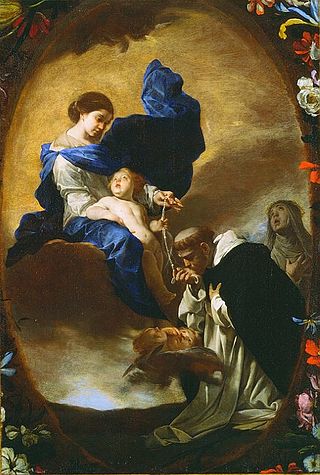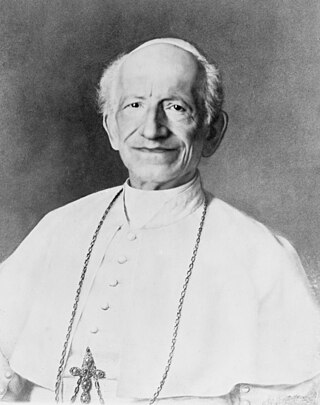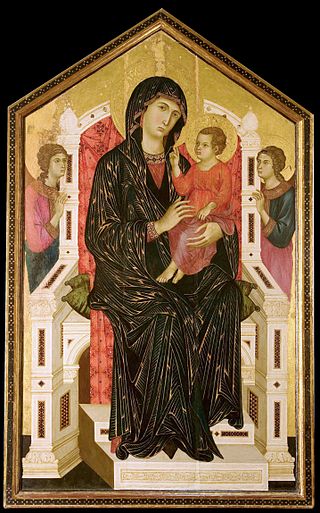
The Rosary, also known as the Dominican Rosary, refers to a set of prayers used primarily in the Catholic Church, and to the physical string of knots or beads used to count the component prayers. When referring to the prayer, the word is usually capitalized ; when referring to the prayer beads as an object, it is written with a lower-case initial letter.

Pope Leo XIII was head of the Catholic Church from 20 February 1878 until his death in July 1903. Living until the age of 93, he was the oldest pope, whose age can be validated, holding office and had the fourth-longest reign of any pope, behind those of St. Peter, Bl. Pius IX and St. John Paul II.

The following are Roman Catholic prayers to Saint Joseph.

Rosarium Virginis Mariae is an apostolic letter by Pope John Paul II, issued on October 16, 2002, which declared from October 2002 to October 2003 as the "Year of the Rosary". It was published by Pope John Paul II in 2002 at the beginning of the twenty-fifth year of his pontificate.

Ad Caeli Reginam is an encyclical of Pope Pius XII, given at Rome, from St. Peter's Basilica, on the feast of the Maternity of the Blessed Virgin Mary, the eleventh day of October, 1954, towards the end of the Marian year, in the sixteenth year of his Pontificate. The encyclical is an important element of the Mariology of Pope Pius XII. It established the feast Queenship of Mary.

Ingruentium malorum is an encyclical of Pope Pius XII on reciting the rosary, issued on September 15, 1951, the Feast of the Seven Sorrows of the Virgin Mary:
It is an appeal for an intensification of the traditional October Rosary devotions, making a particular recommendation for the family recitation of the Rosary, begging Our Lady to obtain peace for individuals, for families, for peoples, for nations, and for the Church throughout the world.

The history of Catholic Mariology traces theological developments and views regarding Mary from the early Church to the 21st century. Mariology is a mainly Catholic ecclesiological study within theology, which centers on the relation of Mary, the Mother of God, and the Church. Theologically, it not only deals with her life but with her veneration in life and prayer, in art, music, and architecture, from ancient Christianity to modern times.

The Mariology of the popes is the theological study of the influence that the popes have had on the development, formulation and transformation of the Roman Catholic Church's doctrines and devotions relating to the Blessed Virgin Mary.

Mediatrix of all graces is a title that some in the Catholic Church give to the Blessed Virgin Mary; as the Mother of God, it includes the understanding that she mediates the Divine Grace. In addition to Mediatrix, other titles are given to her in the Church: Advocate, Helper, Benefactress. In a papal encyclical of 8 September 1894, Pope Leo XIII said: "The recourse we have to Mary in prayer follows upon the office she continuously fills by the side of the throne of God as Mediatrix of Divine grace."

Mariological papal documents have been a major force that has shaped Roman Catholic Mariology over the centuries. Mariology is developed by theologians on the basis not only of Scripture and Tradition but also of the sensus fidei of the faithful as a whole, "from the bishops to the last of the faithful", and papal documents have recorded those developments, defining Marian dogmas, spreading doctrines and encouraging devotions within the Catholic Church.

Le pèlerinage de Lourdes is the only encyclical of Pope Pius XII issued in French. It includes warnings against materialism on the centenary of the apparitions at Lourdes. It was given at Rome, from St. Peter's Basilica, on the feast of the Visitation of the Most Holy Virgin, July 2, 1957, the nineteenth year of his pontificate.
Octobri mense is an encyclical on the Rosary by Pope Leo XIII, also known as the Rosary Pope. It was issued on 22 September 1891 in Saint Peter's Basilica in Rome.
Annum sacrum is an encyclical by Pope Leo XIII on the consecration of the whole human race to the Sacred Heart of Jesus. It was delivered in Saint Peter's Basilica in Rome on 25 May 1899, in the twenty-second year of his pontificate.

Quamquam pluries is an encyclical on Saint Joseph by Pope Leo XIII. It was issued on August 15, 1889 in Saint Peter's Basilica in Rome.
Augustissimae Virginis Mariae is an encyclical by Pope Leo XIII. It was issued 12 September 1897 in Saint Peter's Basilica in Rome. This is an encyclical on the Confraternity of the Holy Rosary.
Christi Matri is an encyclical by Pope Paul VI issued on 15 September 1966 to encourage the faithful to pray for peace by way of the customary special devotions during the month of October, traditionally dedicated in honor of the Most Blessed Virgin.
Supremi apostolatus officio, commonly referred to as "On Devotion of the Rosary", is the first of a number of encyclicals of Pope Leo XIII on the Rosary. It was issued on 1 September 1883, encouraging the practice.
Quod auctoritate is an encyclical published by Pope Leo XIII on 22 December 1885. It has the subtitle: "The Annunciation of an Extraordinary Holy Year", which coincided with the fiftieth anniversary of the pope's ordination.
Vi è ben noto is an encyclical of Pope Leo XIII, dated 20 September 1887, written to the Italian Episcopate for the dedication of the entire month of October to the prayer of the Holy Rosary in order to improve the situation of the Church in Italy and the freedom of the Pontiff.







